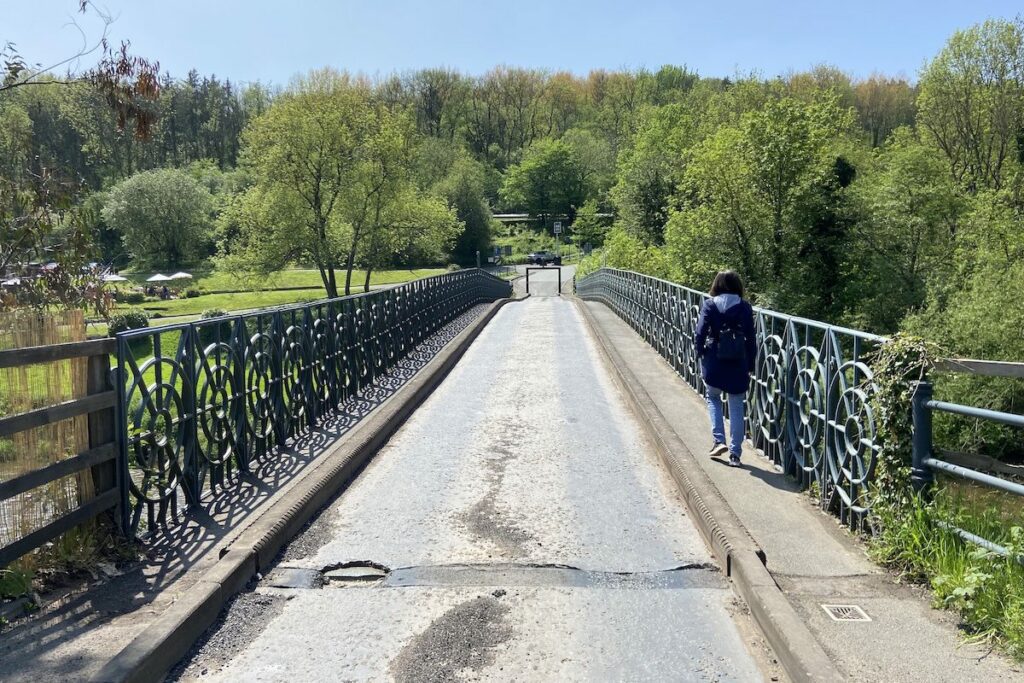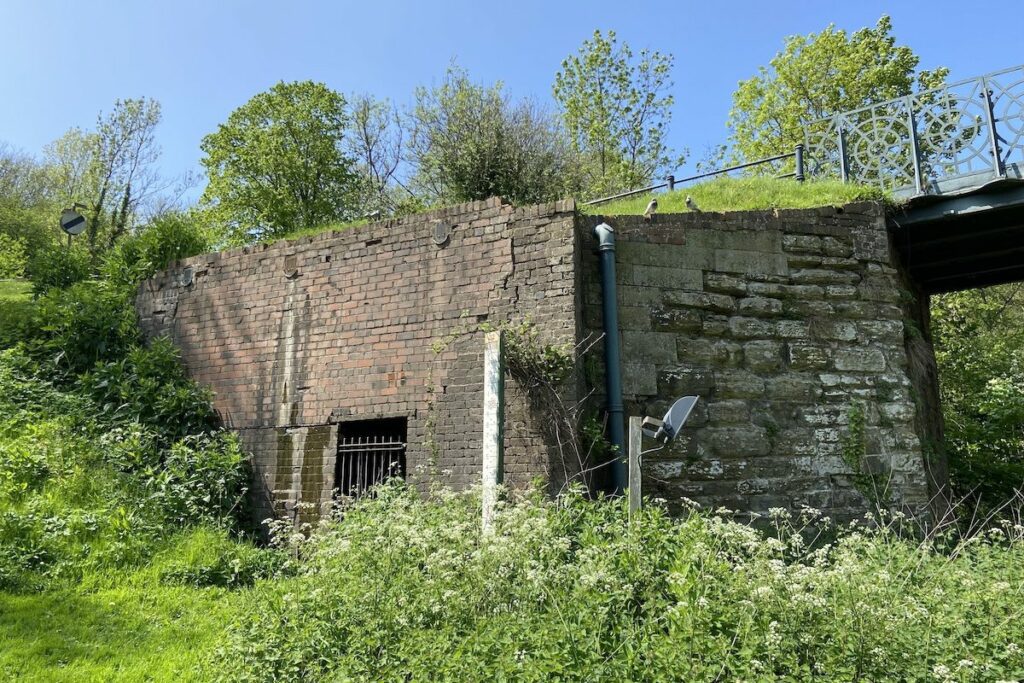Coalport Bridge
Coalport Bridge is a historic single-arch cast iron bridge located in the Ironbridge Gorge. Built in 1818, it spans the River Severn and was originally referred to as the Preens Eddy Bridge. The bridge showcases the rich industrial heritage of the region and is one of the UK’s oldest iron bridges that still carries vehicular traffic.

Key info
| Location | Coalport, TF8 7JA |
| County | Shropshire |
| Completed | 1818 |
| Engineers | William Banks & John Onions |
| Maintained by | Shropshire Council |
| Heritage category | Scheduled Monument Listed Building Grade II* |
Visiting guide
Open 24 / 7
Free entry
Pub car park for patrons
What can I expect when visiting Coalport Bridge?
You can start your tour at either bank of the river. In this guide, we start from the northern approach. Notice the former toll house on the left.

The bridge has a weight restriction of 3 tonnes, a height restriction of 2 metres, and traffic is restricted to a single carriage.

Take time to admire the decorative iron work, which was cast by the iron masters William Banks and John Onions.

As you approach the southern riverbank, notice the pub in the distance called The Woodbridge Inn, a reference to the original bridge made of wood. The inn was built before 1780 when the original bridge was completed and must have been renamed before 1795 when the original bridge was washed away in a great flood.

Follow the road that leads beneath the pub and head down the embankment and upriver for close view of the bridge. Notice the brick pillars, these were constructed to support the second bridge that replaced the original wooden structure. The second bridge was a hybrid of wood, brick, and cast iron and was eventually replaced due to failings in 1818 by the bridge you see today made entirely out of cast iron.

Notice the south abutment made of stone that are original features dating from the first wooden bridge. The abutment has a face of brick that was likely added during the construction of the second bridge and repaired recently with modern brick.

You can now pop into the pub for a pint or head upriver to explore more of the Ironbridge Gorge.d back up the path and continue to our starting position.
How long does it take to visit Coalport Bridge?
It will take you around 15 minutes to see the bridge. You may wish to extend your stay with a visit to The Woodbridge Inn for a pint or continue walking upriver to discover more of the Ironbridge Gorge, which is a UNESO World Heritage Site.
Is Coalport Bridge suitable for a picnic?
There are plenty of green areas along the riverside that are suitable for a picnic.
How do I get to Coalport Bridge?
Coalport is situated in the very eastern part of the Ironbridge Gorge; therefore, it is a little isolated. The nearest bus stops are located roughly 1.5 miles away on Waterloo Street near the Original Free Bridge. If arriving by car, space is limited; therefore, use the car park at The Woodbridge Inn, then you have the perfect excuse to pop by for a drink overlooking Coalport Bridge.
History of Coalport Bridge
1777 – An Act of Parliament is granted for a proposal to build a bridge over the River Severn at Preens Eddy with roads connecting it to the Broseley and Madeley turnpikes. This is why the bridge was originally referred to as Preens Eddy Bridge. Coalport had not yet come into existence until the arrival of the Shropshire Canal the following decade. It’s worth noting The Iron Bridge was also in the process of construction during this year 2 miles upriver and many trustees of said bridge were also trusted with the bridge at Preens Eddy.
The leading protagonist was one Daniel Onions, who occupied the riverside inn now known as The Woodbridge Inn where all of the recorded meetings concerning the bridge were held. Contractors were invited to tender for constructing a timber bridge with stone piers and abutments. A design by William Hayward of two t, an architect from Shrewsbury was chosen and Robert Palmer, a local timber merchant was appointed as constructor.
1780 – The Preens Eddy Bridge is completed and was the first to carry traffic over the River Severn at the Ironbridge Gorge beating The Iron Bridge by nine months.
1789 – Considerable repairs had been made by the year, a drawing of the bridge details several struts protruding from the main structure some extended into the river.
1791 – The original trustee advertises the bridge for sale. The new shareholders are Edward Blake, the ironmaster William Reynolds, and William Ferriday.
1792 – The bridge was rebuilt and most likely included the addition of wrought iron strapping with perhaps some cast iron fenders to protect the bridge from abrasion by tow ropes.
1795 – The bridge is severely damaged by a great flood caused by a sudden thaw. The middle stone pier was reported to be in a ruinous state; therefore, the trustees resorted to discovering another solution to support the bridge.
1799 – The central pier is removed, and a decision was made to support the bridge deck with a single arch made of cast iron. A freestanding brick pier was constructed at a short distance from the original south stone abutment. The northern stone abutment is extended with brick to a height matching its southern freestanding counterpart.
1801 – Work on the second incarnation of the Preens Eddy Bridge is complete. It was described as a wooden bridge supports by 3 sets of cast iron ribs cast by ironmasters William Banks and John Onions (son of Daniel Onions) at a cost of £275 (£16,611 in 2023).
1817 – One of the centre cast iron ribs cracked in two place and a temporary road for horseman and pedestrians was made along one side.
1818 – The broken half rib is replaced, and two more cast iron ribs are added bringing the total to five. The wooden deck was replaced with iron bearers and plates topped with a stone surface. Wooden parapets were also replaced with cast iron. The structure resembles the Coalport Bridge you see today. The cost of the ironwork totals £567 (£39,179 in 2023).
1821 – Assessors found the bridge in good condition and absolved John Onions from further responsibility.
1922 – Ownership of the bridge is transferred to Salop County Council (later named Shropshire Council) [1].
1968 – Coalport Bridge is first listed on the National Heritage List for England as a Grade II* structure [2].
2005 – Coalport Bridge underwent extensive restoration.
2013 – Coalport Bridge is repaired following a wall collapse [3].
Architecture & dimensions
Coalport Bridge is a single span segmental arch made of cast iron on brick abutments from an earlier bridge and ornate cast iron parapet balustrades. Two semi-circular plaques over the centre of the parapets record the name of the bridge and the date of erection [3].
Sources
- Cossons, N. and Trinder, B. (1979) The Iron Bridge. Bradford-on-Avon: Moonraker Press.
- Historic England (2020) Coalport Bridge. Available at: https://historicengland.org.uk/listing/the-list/list-entry/1006235 (Accessed: 11 June 2023).
- (2013) ‘Coalport Bridge opens after repairs’, BBC News. Available at: https://www.bbc.co.uk/news/uk-england-shropshire-24394962 (Accessed: 11 June 2023).

 Coalport China Museum
Coalport China Museum